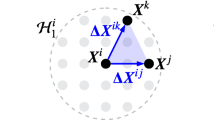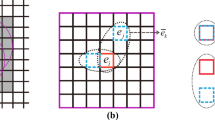Abstract
A deformable spheropolygon-based discrete element method is developed to predict the evolution of fracture by coupling the finite element method (FEM) and the spheropolygon-based discrete element method (DEM). Within the framework of the coupling method, the spheropolygon-based DEM is adopted to capture the discontinuum behaviors, while the continuum behaviors are analyzed by the FEM. By introducing the fracture model of joint elements based on fracture mechanics, a continuous-discontinuous coupling approach for simulating the fracture of quasi-brittle materials is presented. The tensile failure is described with the fictitious crack model, meanwhile, the Mohr–Coulomb failure criterion with a tension cut-off is employed to determine the shear failure state. Finally, the results of numerical simulations indicate that this novel method is versatile in simulating the whole process of quasi-brittle materials from continuum to discontinuum, including the initiation and propagation of cracks, and the collision of fragments after the failure of brittle materials.
Graphic abstract




































Similar content being viewed by others
References
Yu, J., Liu, G.Y., Cai, Y.Y., Zhou, J.F., Liu, S.Y., Tu, B.X.: Time-dependent deformation mechanism for swelling soft-rock tunnels in coal mines and its mathematical deduction. Int. J. Geomech. 20(3), 0401918 (2020)
Komodromos, P.: A simplified updated Lagrangian approach for combining discrete and finite element methods. Comput. Mech. 35(4), 305–313 (2005)
Mao, J., Zhao, L.H., Di, Y.T., Liu, X.N., Xu, W.Y.: A resolved CFD-DEM approach for the simulation of landslides and impulse waves. Comput. Methods Appl. Mech. Eng. 359, 112750 (2020)
Cervera, M., Chiumenti, M.: Smeared crack approach: Back to the original track. Int. J. Numer. Anal. Met. 30(12), 1173–1199 (2006)
Roth, S.N., Leger, P., Soulaimani, A.: A combined XFEM-damage mechanics approach for concrete crack propagation. Comput. Methods Appl. Mech. Eng. 283, 923–955 (2015)
Shi, G.H., Goodman, R.E.: Two dimensional discontinuous deformation analysis. Int. J. Numer. Anal. Met. 9(6), 541–556 (1985)
Fan, H., Zheng, H., Wang, J.F.: A generalized contact potential and its application in discontinuous deformation analysis. Comput. Geotech. 99, 104–114 (2018)
Shi, G.H.: Manifold method of material analysis. Trans. Army Conf. Appl. Math. Comp. US Army Res. Office 57–76 (1991)
Zhang, H.H., Li, L.X., An, X.M., Ma, G.W.: Numerical analysis of 2-D crack propagation problems using the numerical manifold method. Eng. Anal. Bound. Elem. 34(1), 41–50 (2010)
Wu, Z.J., Wong, L.N.Y.: Frictional crack initiation and propagation analysis using the numerical manifold method. Comput. Geotech. 39, 38–53 (2012)
Cundall, P.A.: A computer model for simulating progressive, large-scale movements in blocky rock systems. Paper presented at the Proceedings of symposium of international society of rock mechanics, Nancy, France, pp II-8 (1971)
Sator, N., Hietala, H.: Damage in impact fragmentation. Int J Fracture 163(1–2), 101–108 (2010)
Rabczuk, T., Eibl, J.: Simulation of high velocity concrete fragmentation using SPH/MLSPH. Int. J. Numer. Meth. Eng. 56(10), 1421–1444 (2003)
Das, R., Cleary, P.W.: Effect of rock shapes on brittle fracture using smoothed particle hydrodynamics. Theor Appl Fract Mech 53(1), 47–60 (2010)
An, H.M., Liu, H.Y., Han, H.Y., Zheng, X., Wang, X.G.: Hybrid finite-discrete element modelling of dynamic fracture and resultant fragment casting and muck-piling by rock blast. Comput. Geotech. 81, 322–345 (2017)
Zhu, J.B., Deng, X.F., Zhao, X.B., Zhao, J.: A numerical study on wave transmission across multiple intersecting joint sets in rock masses with UDEC. Rock Mech Rock Eng 46(6), 1429–1442 (2013)
Zhao, L.H., Liu, X.N., Mao, J., Shao, L.Y., Li, T.C.: Three-dimensional distance potential discrete element method for the numerical simulation of landslides. Landslides 17(2), 361–377 (2019)
Liu, K., Liu, W.: Application of discrete element method for continuum dynamic problems. Arch. Appl. Mech. 76(3–4), 229–243 (2006)
Mollon, G., Zhao, J.D.: 3D generation of realistic granular samples based on random fields theory and Fourier shape descriptors. Comput. Method. Appl. Mech. 279, 46–65 (2014)
Effeindzourou, A., Chareyre, B., Thoeni, K., Giacomini, A., Kneib, F.: Modelling of deformable structures in the general framework of the discrete element method. Geotext Geomembr. 44(2), 143–156 (2016)
Baram, R.M., Lind, P.G.: Deposition of general ellipsoidal particles. Phys. Rev. E 85(4), 041301 (2012)
Rubio-Largo, S.M., Lind, P.G., Maza, D., Hidalgo, R.C.: Granular gas of ellipsoids: analytical collision detection implemented on GPUs. Comput. Part Mech. 2(2), 127–138 (2015)
You, Y., Liu, M.L., Ma, H.Q., Xu, L., Liu, B., Shao, Y.L., Tang, Y.P., Zhao, Y.Z.: Investigation of the vibration sorting of non-spherical particles based on DEM simulation. Powder Technol. 325, 316–332 (2018)
Lu, G., Third, J.R., Muller, C.R.: Critical assessment of two approaches for evaluating contacts between super-quadric shaped particles in DEM simulations. Chem. Eng. Sci. 78, 226–235 (2012)
Podlozhnyuk, A., Pirker, S., Kloss, C.: Efficient implementation of superquadric particles in Discrete Element Method within an open-source framework. Comput. Part Mech. 4(1), 101–118 (2017)
Khazeni, A., Mansourpour, Z.: Influence of non-spherical shape approximation on DEM simulation accuracy by multi-sphere method. Powder Technol. 332, 265–278 (2018)
Lu, G., Third, J.R., Muller, C.R.: Discrete element models for non-spherical particle systems: from theoretical developments to applications. Chem. Eng. Sci. 127, 425–465 (2015)
Liu, L., Ji, S.Y.: A new contact detection method for arbitrary dilated polyhedra with potential function in discrete element method. Int. J. Numer. Methods Eng. (2020)
Zhang, H., Chen, G.Q., Zheng, L., Han, Z., Zhang, Y.B., Wu, Y.Q., Liu, S.G.: Detection of contacts between three-dimensional polyhedral blocks for discontinuous deformation analysis. Int. J. Rock Mech. Min. Sci. 78, 57–73 (2015)
Munjiza, A.: The Combined Finite-Discrete Element Method. Wiley, Hoboken, NJ (2004)
Fathani, T.F., Karnawati, D., Wilopo, W.: An integrated methodology to develop a standard for landslide early warning systems. Nat. Hazard Earth Syst. 16(9), 2123–2135 (2016)
Godinez, H.C., Rougier, E., Osthus, D., Lei, Z., Knight, E., Srinivasan, G.: Fourier amplitude sensitivity test applied to dynamic combined finite-discrete element methods-based simulations. Int. J. Numer. Anal. Met. 43(1), 30–44 (2019)
Yan, C.Z., Zheng, H.: A new potential function for the calculation of contact forces in the combined finite-discrete element method. Int. J. Numer. Anal. Met. 41(2), 265–283 (2017)
Zhao, L.H., Liu, X.N., Mao, J., Xu, D., Munjiza, A., Avital, E.: A novel contact algorithm based on a distance potential function for the 3D discrete-element method. Rock Mech. Rock Eng. 51(12), 3737–3769 (2018)
Liu, L., Ji, S.Y.: Bond and fracture model in dilated polyhedral DEM and its application to simulate breakage of brittle materials. Granul. Matter 21(3), 41 (2019)
Hopkins, A., Mark.: Polyhedra faster than spheres?. Eng. Comput. 31(3), 567–583 (2014)
Galindo-Torres, S.A., Pedroso, D.M.: Molecular dynamics simulations of complex-shaped particles using Voronoi-based spheropolyhedra. Phys. Rev. E 81(6), 061303 (2010)
Mark, A., Hopkins, Jukka, Tuhkuri: Compression of floating ice fields. J. Geophys. Res. Oceans 104, 5815–15825 (1999)
Alonso-Marroquin, F.: Spheropolygons: A new method to simulate conservative and dissipative interactions between 2D complex-shaped rigid bodies. Epl-Europhys. Lett. 83(1), 14001 (2008)
Galindo-Torres, S.A., Pedroso, D.M., Williams, D.J., Muhlhaus, H.B.: Strength of non-spherical particles with anisotropic geometries under triaxial and shearing loading configurations. Granul. Matter 15(5), 531–542 (2013)
Behraftar, S., Torres, S.A.G., Scheuermann, A., Williams, D.J., Marques, E.A.G., Avarzaman, H.J.: A calibration methodology to obtain material parameters for the representation of fracture mechanics based on discrete element simulations. Comput. Geotech. 81, 274–283 (2017)
Ji, S., Sun, S., Yan, Y.: Discrete element modeling of dynamic behaviors of railway ballast under cyclic loading with dilated polyhedra. Int. J. Numer. Anal. Met. 41(2), 180–197 (2017)
Alonso-Marroquin, F., Wang, Y.C.: An efficient algorithm for granular dynamics simulations with complex-shaped objects. Granul. Matter 11(5), 317–329 (2009)
Galindo-Torres, S.A., Pedroso, D.M., Williams, D.J., Li, L.: Breaking processes in three-dimensional bonded granular materials with general shapes. Comput. Phys. Commun. 183(2), 266–277 (2012)
Hughes, T.J.R., Liu, W.K.: Nonlinear finite element analysis of shells: Part I. three-dimensional shells. Comput. Method Appl. Mech. 26(3), 331–362 (1981)
Hughes, T.J.R., Liu, W.K.: Nonlinear finite element analysis of shells-part II. two-dimensional shells. Comput. Methods Appl. Mech. Eng. 27(2), 167–181 (1981)
Zhou, X.P., Cheng, H.: Multidimensional space method for geometrically nonlinear problems under total Lagrangian formulation based on the extended finite-element method. J. Eng. Mech. 143(7), 04017036 (2017)
Hillerborg, A., Modéer, M., Petersson, P.-E.: Analysis of crack formation and crack growth in concrete by means of fracture mechanics and finite elements. Cem. Concr. Res. 6(6), 773–781 (1976)
Zheng, F., Zhuang, X.Y., Zheng, H., Jiao, Y.Y., Rabczuk, T.: Kinetic analysis of polyhedral block system using an improved potential-based penalty function approach for explicit discontinuous deformation analysis. Appl. Math. Model. 82, 314–335 (2020)
Zheng, F., Leung, Y.F., Zhu, J.B., Jiao, Y.Y.: Modified predictor-corrector solution approach for efficient discontinuous deformation analysis of jointed rock masses. Int. J. Numer. Anal. Met. 43(2), 599–624 (2019)
Neto, D.M., Oliveira, M.C., Menezes, L.F.: Surface smoothing procedures in computational contact mechanics. Arch. Comput. Method E 24(1), 37–87 (2017)
Patel, S., Martin, C.D.: Evaluation of tensile Young’s modulus and Poisson’s ratio of a bi-modular rock from the displacement measurements in a Brazilian test. Rock Mech. Rock Eng. 51(2), 361–373 (2018)
Hondros, G.: The evaluation of Poisson’s ratio and the modulus of materials of low tensile resistance by the Brazilian (indirect tensile) test with particular reference to concrete. Austral. J. Appl. Sci. 10, 243–268 (1959)
Petersson, P.E.: Crack growth and development of fracture zones in plain concrete and similar materials. Sweden: University of Lund (1981)
Galvez, J.C., Elices, M., Guinea, G.V., Planas, J.: Mixed mode fracture of concrete under proportional and nonproportional loading. Int. J. Fract. 94(3), 267–284 (1998)
Murray, Y., Abu-Odeh, A., Bligh, R.: Evaluation of LS-DYNA Concrete Material Model 159 (2007)
Acknowledgements
This work was supported by the National Natural Science Foundation of China (Grant No. 52009034), the 15th Fok Ying-Tong Education Foundation for Young Teachers in the Higher Education Institutions of China (Grant No. 151073), the Priority Academic Program Development of Jiangsu Higher Education Institutions (Grant YS11001), the 111 Project and Qing Lan Project.
Funding
This study was funded by the National Natural Science Foundation of China (Grant No. 52009034), the 15th Fok Ying-Tong Education Foundation for Young Teachers in the Higher Education Institutions of China (Grant No. 151073), the Priority Academic Program Development of Jiangsu Higher Education Institutions (Grant YS11001), the 111 Project and Qing Lan Project.
Author information
Authors and Affiliations
Contributions
All authors contributed to the study conception and design. Material preparation, data collection and analysis were performed by Lanhao Zhao, Linyu Shao, Jia Mao, Kailong Mu, Tongchun Li. The first draft of the manuscript was written by Linyu Shao and all authors commented on previous versions of the manuscript. All authors read and approved the final manuscript.
Corresponding author
Ethics declarations
Conflict of interest
The authors have no relevant financial or non-financial interests to disclose.
Additional information
Publisher's Note
Springer Nature remains neutral with regard to jurisdictional claims in published maps and institutional affiliations.
Rights and permissions
About this article
Cite this article
Zhao, L., Shao, L., Mao, J. et al. A fracture model for the deformable spheropolygon-based discrete element method. Granular Matter 24, 50 (2022). https://doi.org/10.1007/s10035-022-01206-w
Received:
Accepted:
Published:
DOI: https://doi.org/10.1007/s10035-022-01206-w




